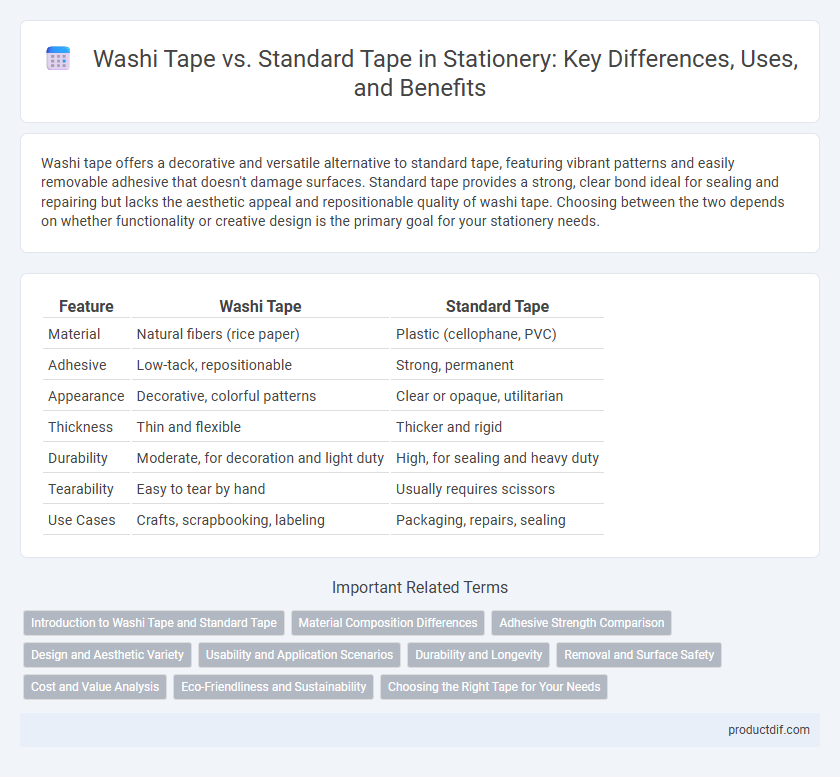Washi tape offers a decorative and versatile alternative to standard tape, featuring vibrant patterns and easily removable adhesive that doesn't damage surfaces. Standard tape provides a strong, clear bond ideal for sealing and repairing but lacks the aesthetic appeal and repositionable quality of washi tape. Choosing between the two depends on whether functionality or creative design is the primary goal for your stationery needs.
Table of Comparison
| Feature | Washi Tape | Standard Tape |
|---|---|---|
| Material | Natural fibers (rice paper) | Plastic (cellophane, PVC) |
| Adhesive | Low-tack, repositionable | Strong, permanent |
| Appearance | Decorative, colorful patterns | Clear or opaque, utilitarian |
| Thickness | Thin and flexible | Thicker and rigid |
| Durability | Moderate, for decoration and light duty | High, for sealing and heavy duty |
| Tearability | Easy to tear by hand | Usually requires scissors |
| Use Cases | Crafts, scrapbooking, labeling | Packaging, repairs, sealing |
Introduction to Washi Tape and Standard Tape
Washi tape, made from natural fibers like bamboo or hemp, offers a decorative and easily repositionable adhesive solution often used in crafts and journaling, distinguishing it from standard tape which typically features a plastic base and a stronger, permanent adhesive. Standard tape excels in practical applications such as sealing packages and repairs due to its durability and robust stickiness. Washi tape's array of colors and patterns enhances creative projects, while standard tape prioritizes functionality and strength in everyday tasks.
Material Composition Differences
Washi tape is crafted from natural fibers such as bamboo, hemp, and traditional Japanese mulberry paper, making it lightweight, flexible, and environmentally friendly. Standard tape typically consists of plastic-based materials like polypropylene or PVC, coated with synthetic adhesives that offer stronger, more durable adhesion but less breathability. The natural composition of washi tape allows for easy repositioning and tearability by hand, whereas standard tape's synthetic material prioritizes strength and moisture resistance.
Adhesive Strength Comparison
Washi tape offers moderate adhesive strength suitable for lightweight paper crafts and temporary applications, as it can be easily repositioned without damaging surfaces. Standard tape provides stronger adhesion designed for heavy-duty tasks, securing materials firmly and enduring various conditions. Choosing between Washi tape and standard tape depends on the required balance between gentle removability and robust sticking power.
Design and Aesthetic Variety
Washi tape offers an extensive range of vibrant patterns and artistic designs, making it ideal for creative projects and decorative purposes. Unlike standard tape, which is typically transparent or plain, washi tape comes in various colors, textures, and prints that enhance visual appeal. Its matte finish and delicate paper texture add a unique aesthetic that standard adhesive tapes lack.
Usability and Application Scenarios
Washi tape offers superior versatility compared to standard tape due to its delicate, decorative design and easy repositioning without residue, making it ideal for scrapbooking, gift wrapping, and crafting. Standard tape excels in strong adhesion and durability, suitable for packaging, sealing, and everyday repairs where a secure hold is essential. Both tapes serve distinct purposes: washi tape enhances visual appeal and temporary applications, while standard tape provides reliable functionality for permanent or heavy-duty tasks.
Durability and Longevity
Washi tape offers moderate durability with a delicate paper texture that is resistant to tearing but not waterproof, making it ideal for decorative uses rather than heavy-duty applications. Standard tape, typically made from plastic or vinyl materials, provides superior durability and longevity, maintaining adhesive strength over time and performing well under varied environmental conditions. When durability and long-term adhesion are priorities, standard tape outperforms washi tape, which excels in aesthetic appeal and easy removability.
Removal and Surface Safety
Washi tape features a low-tack adhesive that removes cleanly without leaving residue or damaging surfaces, making it ideal for delicate paper, walls, and furniture. Standard tape often uses stronger adhesives that can peel paint, tear paper, or leave sticky residue upon removal. The gentle adhesion of washi tape ensures safe application and easy repositioning, preserving the integrity of various surfaces compared to conventional tape options.
Cost and Value Analysis
Washi tape typically costs between $3 to $6 per roll, offering a decorative appeal and repositionable adhesive that enhances its value for crafting and gift wrapping. Standard tape, priced around $1 to $3 per roll, provides stronger adhesion and durability suited for general-purpose use but lacks aesthetic versatility. Evaluating cost per use, washi tape delivers greater artistic value while standard tape offers practical affordability for everyday tasks.
Eco-Friendliness and Sustainability
Washi tape, made from natural fibers like bamboo or hemp, offers a biodegradable and eco-friendly alternative to standard plastic-based tapes, which contribute to landfill waste and environmental pollution. Its sustainable production process uses renewable resources and typically avoids harmful chemicals, reducing carbon footprint compared to conventional tapes made from petroleum-based materials. Choosing washi tape supports environmentally conscious crafting and packaging, aligning with green practices and reducing plastic dependency.
Choosing the Right Tape for Your Needs
Washi tape offers a decorative, low-tack adhesive perfect for scrapbooking, journaling, and delicate surfaces, while standard tape provides a stronger, more durable hold ideal for packaging and everyday repairs. Choosing the right tape depends on project requirements: select washi tape for aesthetics and easy repositioning, and standard tape for secure bonding and utility. Consider surface type, adhesive strength, and design preferences to ensure optimal results.
Washi tape vs Standard tape Infographic

 productdif.com
productdif.com